#Anthologia Planudea
Text
On the Minotaur
Anthologia Planudea 126 (author and date unknown)
The child who is also a bull, the finished-in-no-respect,
The denouncer of his mother’s lust, the human-mixed-with-beast,
The double nature, the bull-skulled, the confusion of two bodies,
Who was born neither as a cow nor as a man altogether.
ὁ παῖς ὁ ταῦρος, ὁ κατὰ μηδὲν ἐντελής,
ὁ τῆς τεκούσης τοῦ πάθους κατήγορος,
ὁ μιξόθηρ ἄνθρωπος, ἡ διπλῆ φύσις,
ὁ ταυρόκρανος, ἡ πλάνη τῶν σωμάτων,
ὃς οὔτε βοῦς πέφυκεν, οὔτ᾽ ἀνὴρ ὅλως.

The Minotaur, from a statue group representing his combat with Theseus. Roman copy after a lost Greek original by the sculptor Myron that was located on the Acropolis. Now in the National Archaeological Museum, Athens. Photo credit: Marsyas/Wikimedia Commons.
#classics#tagamemnon#Ancient Greece#classical mythology#Greek mythology#Minotaur#Greek#Greek language#Ancient Greek#Ancient Greek language#translation#Greek translation#Ancient Greek translation#poem#poetry#poetry in translation#epigram#iambic trimeter#Anthologia Planudea#Planudean Anthology#Anthologia Graeca#Greek Anthology
225 notes
·
View notes
Text
Moerbeke Archimedes is Now Online
My friend Pieter Beullens discovered and made known today that the Archimedes Codex of William of Moerbeke at the Vatican Library is online at last. Although this Latin book is probably their most historic digital publication of 2018, the coders at Digita Vaticana have somehow botched the release, lodging the manuscript in the wrong area of the portal, where no one would ever look for it.
Only three witnesses in the original Greek of the works of Archimedes -- A, B, and C -- are known to have survived the Byzantine period.
C is the privately owned Archimedes Palimpsest (images) which is the famous subject of the book The Archimedes Codex by Reviel Netz and William Noel (2007).
B, not recorded since 1311.
A was last seen in 1564, but was copied several times, foremost by Poliziano, whose apograph, imitating the writing and mise en page of the antigraph, is in Florence and online (ms. Plut.28.4)
William of Moerbeke, who was a Dominican, generally taken to be Flemish, used A and B to compile a Latin version of Archimedes in or about 1269. William is a giant in the medieval transmission of the classics (see Pieter Beullens' tweets for a feeling). In 1881, it was realized that codex Ott.lat.1850 at the Vatican is the draft/original/autograph of the Archimedes part of his work.
You can now page through Ott.lat.1850. The Moerbeke pages are bound together with two extraneous parts, one of them printed Latin text.When this posting went up, the URL was https://digi.vatlib.it/view/Ott.lat.1850, which wrongly places it among the incunables and in fact should attach to Cardinal Ottoboni's own copy of the Anthologia Graeca Planudea (ia00765000).
Why is the Moerbeke codex historic? Firstly, it was the only witness of the text of Floating Bodies until the beginning of the 20th century and the discovery of C above. Secondly it is our only means of accessing B. Thirdly, it can guide us to what copyists of A may have overlooked. And fourthly, with Moerbeke's own marginal notes, it is itself a major artefact in the history of science.
via Blogger https://ift.tt/2Kug9c5
0 notes
Text
On a Statue of Capaneus
Anthologia Planudea 106 (author and date unknown)
Note: in Greek mythology, Capaneus was one of the seven chieftains who attacked Thebes in support of Polynices’ claim to the throne. As he was about to storm the citadel by means of a ladder, he shouted that Zeus himself would not stop him from taking the city. This earned him a swift death by lightning bolt. Dante, in the Inferno, places Capaneus in the seventh circle of Hell as a blasphemer.
If such a Capaneus had raged against the towers of Thebes,
Having contrived an ascent into the air with a ladder,
He would have seized the citadel by force, Fate notwithstanding –
For even Zeus’ bolt would have scrupled to cut down such a fighter.
εἰ τοῖος Θήβης Καπανεὺς ἐπεμήνατο πύργοις,
ἄμβασιν ἠερίην κλίμακι μησάμενος,
εἷλεν ἂν ἄστυ βίῃ καὶ ὑπὲρ μόρον. αἴδετο γάρ ῥα
καὶ σκηπτὸς Κρονίδου τοῖον ἑλεῖν πρόμαχον.

A scene from Aeschylus' Seven Against Thebes: Capaneus ascends the walls of Thebes. Campanian red-figure neck-amphora, attributed to the Caivano Painter; ca. 340 BCE. Now in the Getty Villa, Malibu. Photo credit: Wolfgang Sauber.
#classics#tagamemnon#Greek#Ancient Greek#Greek language#Ancient Greek language#translation#Greek translation#Ancient Greek translation#poem#poetry#poetry in translation#Greek mythology#classical mythology#epigram#Anthologia Planudea#Planudean Anthology#Anthologia Graeca#Greek Anthology#elegiac couplets#quatrain
48 notes
·
View notes
Text
On the Famed Statue of Cnidian Aphrodite
Anthologia Planudea 161, attributed to Plato
Note: “when being judged” = a reference to the Judgment of Paris that sparked the Trojan War.
Neither did Praxiteles shape you,
Nor did the iron tool;
But you struck a pose in just the way
You once did when being judged.
οὔτε σε Πραξιτέλης τεχνάσατο, οὔθ᾽ ὁ σίδαρος:
ἀλλ᾽ οὕτως ἔστης, ὥς ποτε κρινομένη.

Aphrodite of Cnidus. Roman-era marble copy after the lost 4th century BCE original of Praxiteles, extensively restored by Ippolito Buzzi (1562-1634). Now in the Palazzo Altemps, Rome.
#classics#tagamemnon#Greek#Ancient Greek#Greek language#Ancient Greek language#translation#Greek translation#Ancient Greek translation#poem#poetry#poetry in translation#couplet#elegiac couplets#epigram#Plato#Anthologia Planudea#Planudean Anthology#Anthologia Graeca#Greek Anthology#Aphrodite#Praxiteles#Ancient Greece
43 notes
·
View notes
Text
On a Statue of a Bacchant at Byzantium
Anthologia Planudea 57 = Paulus Silentiarius (6th cent. CE)
It was not Nature, but rather Art
That made the Bacchant out of her mind
And mingled madness throughout the stone.
ἔκφρονα τὴν βάκχην οὐχ ἡ φύσις, ἀλλ᾽ ἡ τέχνη
θήκατο, καὶ μανίην ἐγκατέμιξε λίθῳ.
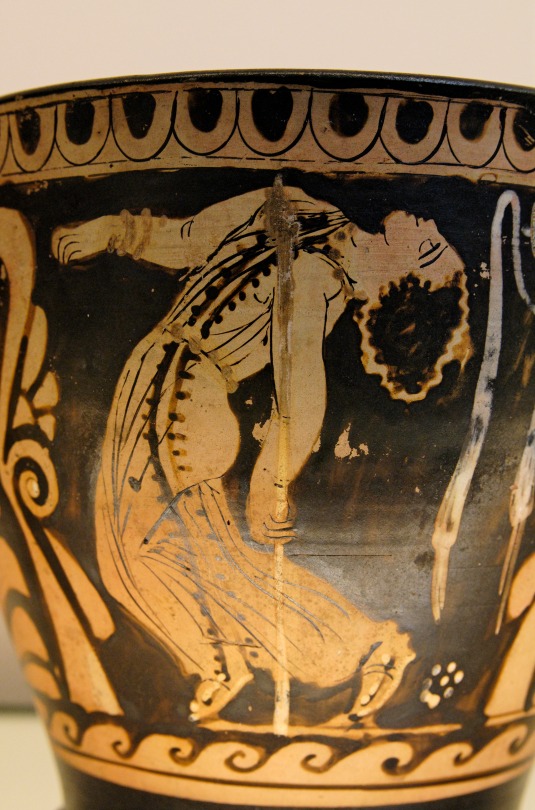
A dancing maenad. Detail from a red-figure skyphos by the painter Python, ca. 330-320 BCE. From Paestum (Poseidonia), Italy; now in the British Museum. Photo credit: © Marie-Lan Nguyen / Wikimedia Commons.
#classics#tagamemnon#Ancient Greece#Greek#Ancient Greek#Greek language#Ancient Greek language#Greek translation#Ancient Greek translation#langblr#poem#poetry#poetry in translation#Greek poetry#Ancient Greek poetry#Byzantine Empire#Byzantine poetry#Paulus Silentarius#Paul the Silentiary#couplet#elegiac couplets#epigram#Anthologia Planudea#Planudean Anthology#Anthologia Graeca#Greek Anthology
310 notes
·
View notes
Text
Fallen in Their Prime
Anthologia Planudea 26 = Simonides
Note: This epitaph commemorates the Athenians killed during a victory over the Euboean city of Chalcis in 504 BCE. Dirphys is a mountain on Euboea; Euripus is the strait separating Attica and Euboea.
Beneath the fold of Dirphys we were slain; a mound
At public cost was poured on us near Euripus,
Not unjustly: for we lost our lovely youth
When we received the gritty cloud of war.
Δίρφυος ἐδμήθημεν ὑπὸ πτυχί: σῆμα δ᾽ ἐφ᾽ ἡμῖν
ἐγγύθεν Εὐρίπου δημοσίᾳ κέχυται,
οὐκ ἀδίκως: ἐρατὴν γὰρ ἀπωλέσαμεν νεότητα,
τρηχεῖαν πολέμου δεξάμενοι νεφέλην.
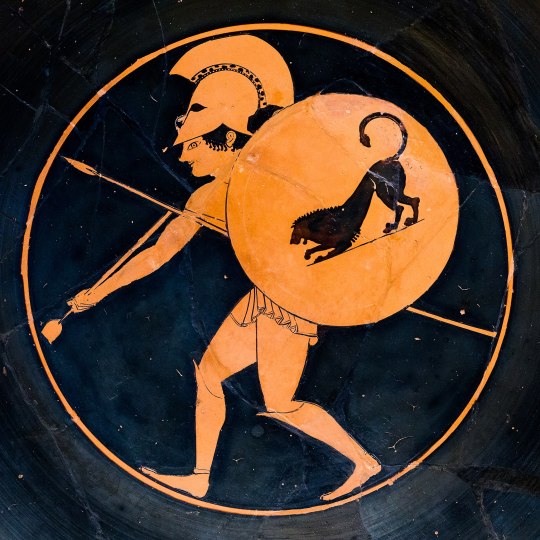
A hoplite with lion shield and trumpet. Interior of an Attic red-figure kylix (drinking cup), made by the potter Euxitheos and painter Oltos ca. 515-510 BCE. From Vulci; now in the Altes Museum, Berlin. Photo credit: ArchaiOptix/Wikimedia Commons.
#classics#tagamemnon#Ancient Greece#Archaic Greece#ancient history#Greek history#Ancient Greek history#Greek#Greek language#Ancient Greek#Ancient Greek language#translation#Greek translation#Ancient Greek translation#langblr#poem#poetry#poetry in translation#Simonides#epigram#epitaph#elegiac couplets#Anthologia Graeca#Greek Anthology#Anthologia Planudea#Planudean Anthology
72 notes
·
View notes
Text
On a Bronze Statue of Alexander the Great
Anthologia Planudea 120, variously attributed to Asclepiades or Archelaus
Alexander’s daring, Alexander’s entire form –
These Lysippus has copied; what power’s in this bronze!
The metal man seems about to speak as he looks up to the sky:
“The earth I place beneath my feet; Zeus, you may keep Olympus.”
τόλμαν Ἀλεξάνδρου καὶ ὅλαν ἀπεμάξατο μορφὰν
Λύσιππος: τίν᾽ ὁδὶ χαλκὸς ἔχει δύναμιν;
αὐδασοῦντι δ᾽ ἔοικεν ὁ χάλκεος ἐς Δία λεύσσων:
‘γᾶν ὑπ᾽ ἐμοὶ τίθεμαι: Ζεῦ, σὺ δ᾽ Ὄλυμπον ἔχε.'
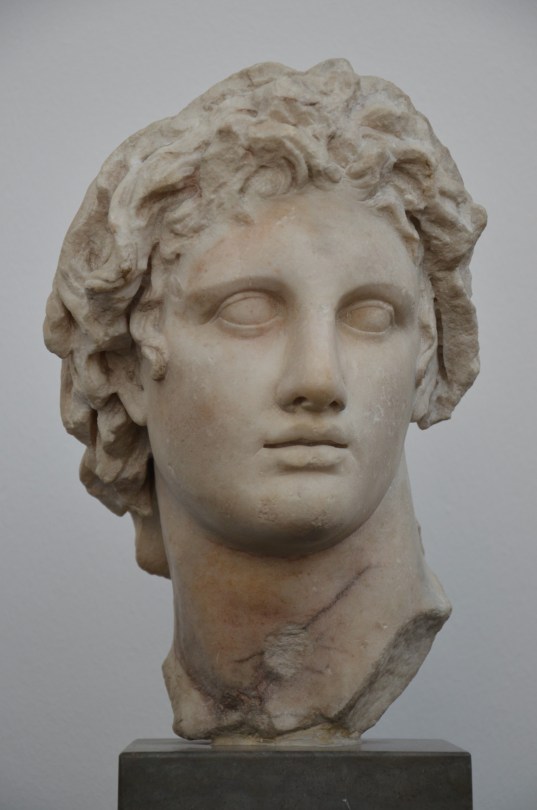
Alexander the Great. Marble copy by an unknown artist of the 3rd century BCE, after a lost bronze original by the sculptor Lysippus. From Alexandria, Egypt; now in the Ny Carlsberg Glyptotek, Copenhagen. Photo credit: Carole Raddato.
#classics#tagamemnon#Greek#Greek language#Ancient Greek#Ancient Greek language#langblr#poem#poetry#translation#poetry in translation#Greek translation#Ancient Greek translation#ancient history#Ancient Greece#Alexander the Great#Hellenistic period#Greek poetry#Ancient Greek poetry#Hellenistic poetry#Asclepiades#Archelaus#epigram#ecphrasis#quatrain#elegiac couplets#Anthologia Planudea#Planudean Anthology#Anthologia Graeca#Greek Anthology
244 notes
·
View notes
Text
The Quest for Repose
Anthologia Planudea 230 = Leonidas of Tarentum (fl. 3rd cent. BCE)
Traveler, do not drink here, in this sheep-country,
From this hot torrent-water, teeming with mud.
But go a little distance over the peak where cows graze,
Yonder beside that pine tree shepherds haunt,
And you will find, gurgling through rock of fine fountains,
A stream that is colder than the North Wind’s snow.
μὴ σὺ γ᾽ ἐπ᾽ οἰονόμοιο περίπλεον ἰλύος ὧδε
τοῦτο χαραδραίης θερμόν, ὁδῖτα, πίῃς:
ἀλλὰ μολὼν μάλα τυτθὸν ὑπὲρ δαμαλήβοτον ἄκραν
κεῖσέ γε πὰρ κείνᾳ ποιμενίᾳ πίτυϊ
εὑρήσεις κελαρύζον ἐϋκρήνου διὰ πέτρης
νᾶμα, Βορειαίης ψυχρότερον νιφάδος.
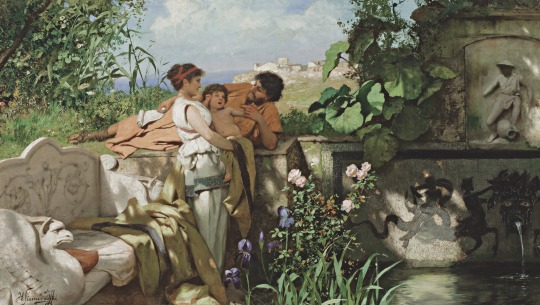
By the Fountain, Henryk Siemiradzki (1843-1902)
#classics#tagamemnon#Greek#Greek language#Ancient Greek#Ancient Greek language#langblr#Greek translation#Ancient Greek translation#poem#poetry#poetry in translation#Greek poetry#Ancient Greek poetry#pastoral poetry#bucolic poetry#Ancient Greece#Hellenistic period#Hellenistic poetry#Leonidas of Tarentum#epigram#elegiac couplets#Anthologia Planudea#Planudean Anthology#Anthologia Graeca#Greek Anthology#Henryk Siemiradzki
186 notes
·
View notes
Text
Pan the Victory-Bringer
Anthologia Planudea 259 (author unknown)
Note: The Athenians began to honor Pan in earnest after the campaign and battle of Marathon (490 BCE). When the runner Pheidippides was sent to ask help from Sparta against the Persians, he encountered Pan, who promised aid on the battlefield in exchange for worship at Athens.
The Athenians made me out of Parian marble
And erected me upon the citadel
Of Pallas – I am Pan Who Bears the Trophy.
πέτρης ἐκ Παρίης με πόλιν κατὰ Παλλάδος ἄκρην
στῆσαν Ἀθηναῖοι Πᾶνα τροπαιοφόρον.

Table support (Pentelic marble) in the shape of the god Pan. Roman copy (2nd cent. CE) after a Greek original of the 4th century BCE. Now in the National Archaeological Museum, Athens. Photo credit: Zde/Wikimedia Commons.
#classics#tagamemnon#Ancient Greece#Greek religion#Ancient Greek religion#Hellenic polytheism#God Pan#Greek#Greek language#Ancient Greek#Ancient Greek language#translation#Greek translation#Ancient Greek translation#langblr#poem#poetry#poetry in translation#Greek poetry#Ancient Greek poetry#epigram#dedicatory epigram#couplet#elegiac couplets#Anthologia Graeca#Greek Anthology#Anthologia Planudea#Planudean Anthology
107 notes
·
View notes
Text
On a Statue of Pan
Anthologia Planudea 232 = Simonides
Note: According to Herodotus, when Phidippides was sent to summon help from Sparta before the battle of Marathon, Pan appeared to him and offered his aid. After the Athenian victory, Miltiades established a cult of the god.
Miltiades put me here –
Pan, the one with goat-feet,
The one from Arcadia,
The one who opposes Medes,
The one who favors Athenians.
τὸν τραγόπουν ἐμὲ Πᾶνα, τὸν Ἀρκάδα, τὸν κατὰ Μήδων,
τὸν μετ᾽ Ἀθηναίων, στήσατο Μιλτιάδης.
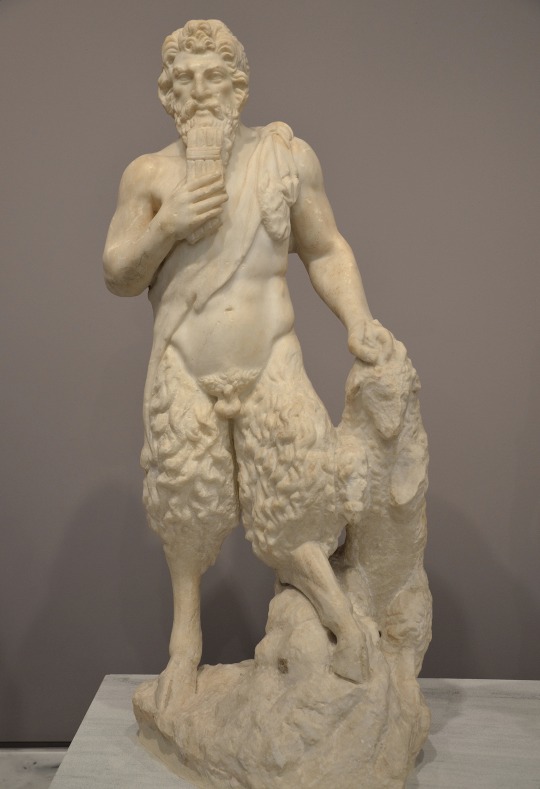
Small marble statue of Pan. Artist unknown; 2nd cent. CE. Found at Argyroupoli (=ancient Lappa), Crete; now in the Archaeological Museum of Heraklion. Photo credit: Carole Raddato.
#classics#tagamemnon#Greek#Ancient Greek#Greek language#Ancient Greek language#translation#Greek translation#Ancient Greek translation#poem#poetry#poetry in translation#Greek religion#Ancient Greek religion#Hellenic polytheism#God Pan#Ancient Greece#Classical Greece#ancient history#Persian Wars#Greco-Persian Wars#Battle of Marathon#Simonides#epigram#dedicatory epigram#couplet#elegiac couplets#Anthologia Planudea#Planudean Anthology#Anthologia Graeca
68 notes
·
View notes
Text
On a Cup with an Image of Tantalus
Anthologia Planudea 89 = Gallus
This man who dined before with the blessed gods,
This man who filled his belly many a time
With draughts of nectar, now longs for mortal drink:
But the grudging mixture’s always lower than his lips.
“Drink,” says the relief, “and learn the rites of silence:
“thus are we punished who can’t control our tongues.”
οὗτος ὁ πρὶν μακάρεσσι συνέστιος, οὗτος ὁ νηδὺν
πολλάκι νεκταρέου πλησάμενος πόματος,
νῦν λιβάδος θνητῆς ἱμείρεται: ἡ φθονερὴ δὲ
κρᾶσις ἀεὶ χείλευς ἐστὶ ταπεινοτέρη.
‘ πῖνε,’ λέγει τὸ τόρευμα, ‘καὶ ὄργια μάνθανε σιγῆς:
‘οἱ γλώσσῃ προπετεῖς ταῦτα κολαζόμεθα.’
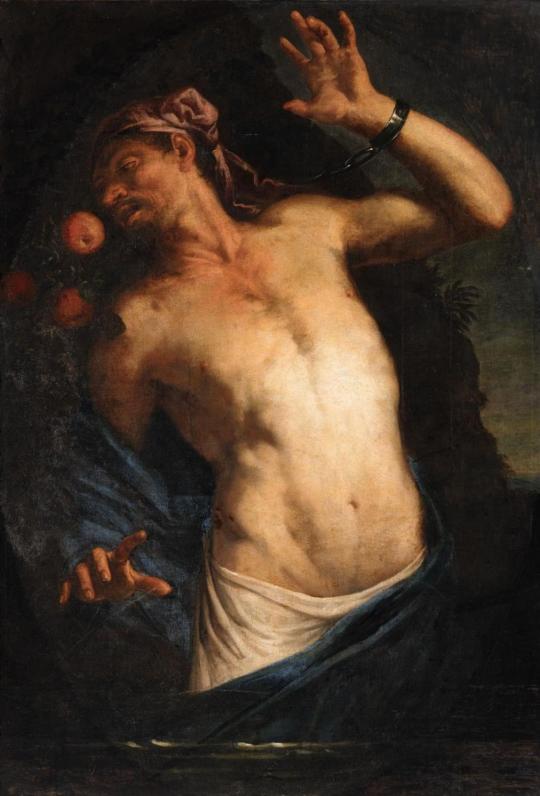
Tantalus, tentatively attributed to Giovanni Battista Langetti (1635-1676)
#classics#tagamemnon#Greek#Greek language#Ancient Greek#Ancient Greek language#langblr#translation#Greek translation#Ancient Greek translation#poem#poetry#poetry in translation#Greek poetry#Ancient Greek poetry#classical mythology#Tantalus#Tantalos#epigram#ecphrasis#ekphrasis#ecphrastic epigram#elegiac couplets#Anthologia Planudea#Planudean Anthology#Anthologia Graeca#Greek Anthology#Gallus#Giovanni Battista Langetti
38 notes
·
View notes
Text
The Statue of Cnidian Aphrodite Speaks
Anthologia Graeca 16.168 (author and date unknown)
Paris saw me naked; Anchises too;
Likewise Adonis. I know of none
Besides those three. So how in the world
Did Praxiteles pull it off?!
Γυμνὴν εἶδε Πάρις με καὶ Ἀγχίσης καὶ Ἄδωνις·
τοὺς τρεῖς οἶδα μόνους. Πραξιτέλης δὲ πόθεν;

Roman statue of Aphrodite/Venus, modeled after a Greek original by the sculptor Praxiteles. Now in the Getty Museum, Los Angeles. Photo credit: Shawn Lipowski.
#classics#tagamemnon#Ancient Greek#Ancient Greece#poem#poetry#translation#epigram#classical mythology#Aphrodite#Venus#Praxiteles#Anthologia Graeca#Greek Anthology#Anthologia Planudea#Planudean Anthology
246 notes
·
View notes
Text
Getting to Grips with Greatness
Anthologia Planudea 4.55 = Troilus Grammaticus (prob. 5th cent. CE)
Tell me, statue, who was it who dedicated you?
Why were you set up? For whom are you an honor?
“It was to honor Lyron the city set me up,
In return for the skill that he showed in wrestling.”
Εἰκών, τίς σ’ ἀνέθηκε, τίνος χάριν ἢ τίνι, λέξον. —
„Ἀντὶ παλαισμοσύνης θῆκε Λύρωνι πόλις.“

Bronze cista handle from Praeneste, in the shape of two wrestlers. Artist unknown; 4th cent. BCE. Now in the Walters Art Museum, Baltimore. Photo credit: Walters Art Museum.
#classics#tagamemnon#Ancient Greece#Ancient Greek#poem#poetry#translation#epigram#Troilus Grammaticus#late antiquity#Roman Empire#Late Roman Empire#Anthologia Planudea#Planudean Anthology#ancient athletics
59 notes
·
View notes
Text
A Cool Rest for Wayfarers
Anthologia Planudea 11 = Hermocreon (3rd cent. BCE?)
O stranger, as you pass by, sit
Beneath this shady plane-tree,
Whose leaves the West Wind sets to quivering
With his gentle gusts.
Here Nicagoras set me up –
Hermes, Maia’s son –
To keep watch over his fruit-rich fields
And his herds of cattle.
Ἵζευ ὑπὸ σκιερὰν πλάτανον, ξένε, τάνδε παρέρπων,
ἇς ἁπαλῷ Ζέφυρος πνεύματι φύλλα δονεῖ,
ἔνθα με Νικαγόρας κλυτὸν εἵσατο Μαιάδος Ἑρμᾶν
ἀγροῦ καρποτόκου ῥύτορα καὶ κτεάνων.

The Patrician’s Siesta, Henryk Siemiradzki, 1881
#classics#tagamemnon#Ancient Greek#Ancient Greece#Hellenistic period#Hellenistic Greece#poem#poetry#translation#poetry in translation#epigram#Hellenic polytheism#Greek religion#Ancient Greek religion#Hermes#Hermocreon#Hellenistic poetry#elegiac couplets#Anthologia Graeca#Greek Anthology#Anthologia Planudea#Planudean Anthology#Henryk Siemiradzki
80 notes
·
View notes